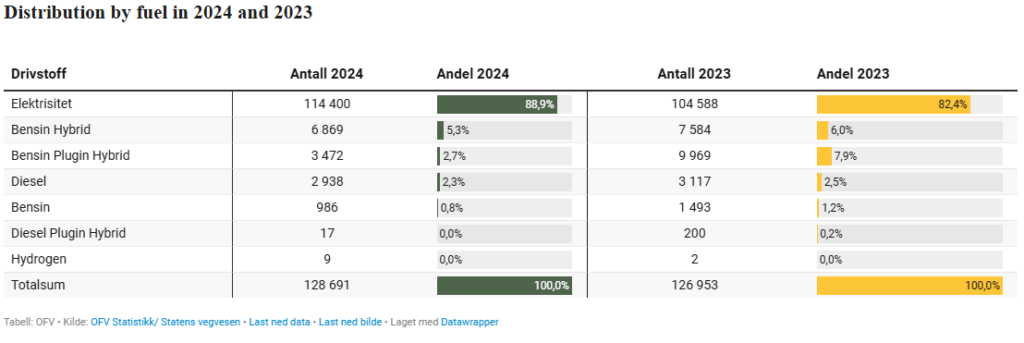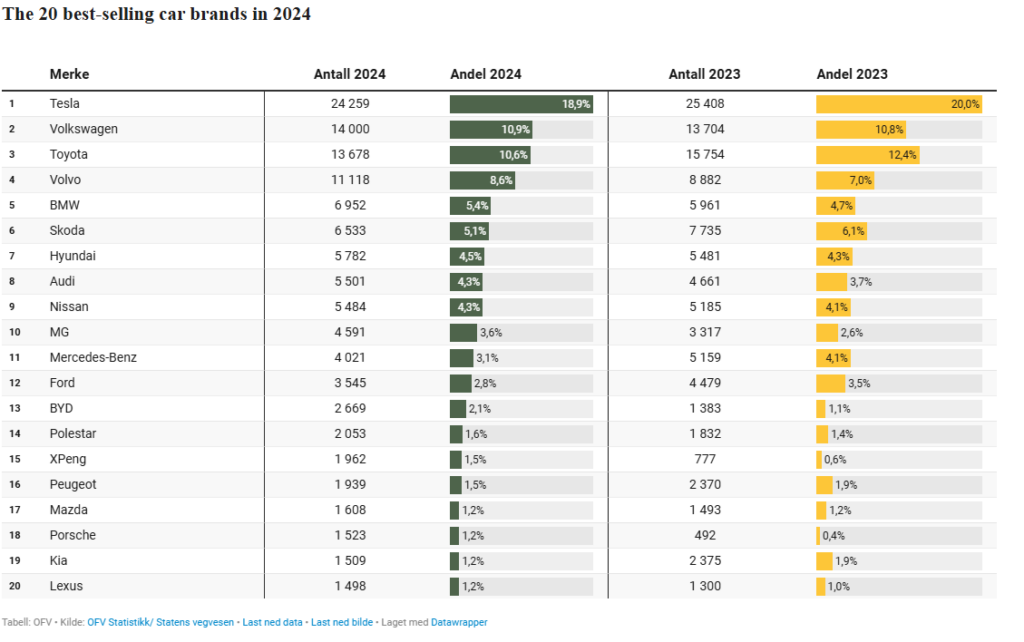If there is anyone who still wonders why this war is being fought, let him look to Norway. If there is anyone who has any delusions that this war could have been averted, let him look to Norway; and if there is anyone who doubts the democratic will to win, again I say, let him look to Norway.
Franklin D. Roosevelt (16 September 1942)
Norway is well ahead of the curve of EV adaptation, in good part for not having a car industry of their own. This makes developments there of more general interest.
The Norwegian Road Federation, a car interest organisation, just published some useful car-related statistics:
New car sales in 2024: 9 out of 10 new passenger cars were electric cars
In December alone, 13,652 new passenger cars were registered, 12.1 percent more than in the same month in 2023. The electric car share in December 2024 was 85.5 percent, compared to 73.5 percent in the same month the previous year. Throughout 2024, the electric car share of new car sales in individual months has been well over 90 percent, with September as a record month with a whopping 96.4 percent
The Google translation is spotty, doesn’t translate embedded tables (assumedly iframes), but Norwegian is sufficiently close for most part, drivstoff = fuel, antall = number, andel = share.

Pure petrol (bensin) cars are disappearing, only sold as hybrids, so petrol heads have turned into diesel head. The diesel+hybrid share is relatively stable at 2.3% (-0.4%), while petrol+hybrid is 8.8% (-6.1%). Notably hydrogen car sales have increased with 350% last year, from 2 to 9, so hydrogen must be the future.
The target in Norway has been 100% BEV by 2025 (1 January IIRC, not 31 December) for cars and light vans, so there is a clear shortfall. Originally a ban of fossil cars was considered, but sales seemed on track anyway, so that was dropped. Now there are still 12% mostly hybrids sold.

The other targets for 2025 have also fallen short. 100% of city buses were to be electric, but only 81.2% were. Worse, only 29.3% of light vans were (range 13%-49% by county).
The targets for 2030, 100% heavy vans (29.1% in 2024), 75% long distance buses (26.5%) and 50% heavy goods vehicles (12.1%), aren’t on track either. There is no target for motorcycles, but 8.5% of light motorcycles and 5.1% of heavy motorcycles are electric.
In the fleet 28.4% of cars, 7.5% of light vans, 18.4% of city buses, 3.1% of heavy goods vehicles, 2.1% of light motorcycles, and 41.2% of car ferries are electric.
– The figures and the increase in share show that the last few percentages to reach the 2025 target may be difficult to achieve. It sends a clear message to the government that it is absolutely crucial to maintain incentives that provide benefits for purchasing electric cars if the government and the Storting are to reach the target they have set themselves, says Director Øyvind Solberg Thorsen of the Norwegian Road Traffic Information Council (OFV).
– We are now looking towards an economic recovery, and many new and exciting car brands and models are on their way to Norway in 2025. If the electric car incentives are maintained, new car sales could gain momentum and help us reach the 2025 target. Many of the new models have a price and equipment level that suits many people’s needs and wallets, he says.
The trend over the last couple of years has been that we are now buying smaller and more affordable new cars than when interest rates and price levels were far lower, and there is much to suggest that this will also affect new car sales in 2025.
Tesla is still the strongest brand in Norway, but keeps losing market share, and actual sales numbers. Not anything dramatic, so if there is an “Elon effect” it is slight, at least in 2024.
Biggest loser year-on-year was Toyota, while Skoda, Mercedes-Benz and Ford also sold less in 2024 than in 2023. While car sales in total increased with just 1.0%, EV sales increased with 9.4%.

